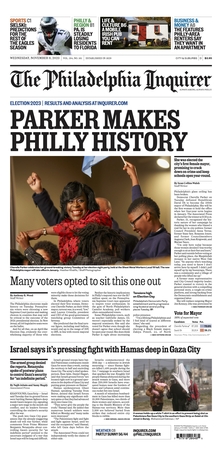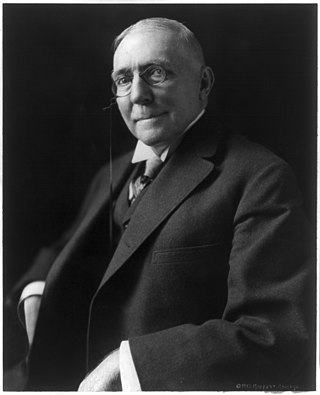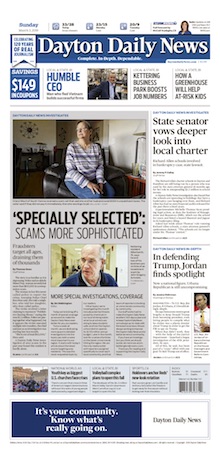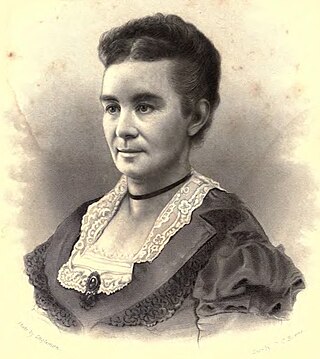Related Research Articles

The Philadelphia Inquirer, often referred to simply as The Inquirer, is a daily newspaper headquartered in Philadelphia, Pennsylvania. Founded on June 1, 1829, The Philadelphia Inquirer is the third-longest continuously operating daily newspaper in the nation.
The News was an afternoon daily tabloid newspaper in the city of Adelaide, South Australia, that had its origins in 1869, and ceased circulation in 1992. Through much of the 20th century, The Advertiser was Adelaide's morning broadsheet, The News the afternoon tabloid, with The Sunday Mail covering weekend sport, and Messenger Newspapers community news.
The Honolulu Star-Bulletin was a daily newspaper based in Honolulu, Hawaii, United States. At the time publication ceased on June 6, 2010, it was the second largest daily newspaper in the state of Hawaiʻi.

James Whitcomb Riley was an American writer, poet, and best-selling author. During his lifetime he was known as the "Hoosier Poet" and "Children's Poet" for his dialect works and his children's poetry. His poems tend to be humorous or sentimental. Of the approximately 1,000 poems Riley wrote, the majority are in dialect. His famous works include "Little Orphant Annie" and "The Raggedy Man".

The Dayton Daily News (DDN) is a daily newspaper published in Dayton, Ohio. It is owned by Cox Enterprises, Inc., a privately held global conglomerate headquartered in Atlanta, Georgia, United States, with approximately 55,000 employees and $21 billion in total revenue. Its major operating subsidiaries are Cox Communications, Cox Automotive, and Ohio Newspapers.

Edgar Doud Whitcomb was an American attorney, writer and politician, who served as the 43rd governor of Indiana. His term as governor began a major rift in the Indiana Republican Party as urban Republicans became more numerous than rural Republicans, leading to a shift in the priorities of the party leadership.

The Indianapolis Star is a morning daily newspaper that began publishing on June 6, 1903, in Indianapolis, Indiana, United States. It has been the only major daily paper in the city since 1999, when the Indianapolis News ceased publication. It won the Pulitzer Prize for National Reporting in 2021 and the Pulitzer Prize for Investigative Reporting twice, in 1975 and 1991. It is currently owned by Gannett.

The Republican is a newspaper based in Springfield, Massachusetts, covering news in the Greater Springfield area, as well as national news and pieces from Boston, Worcester and northern Connecticut. It is owned by Newhouse Newspapers, a division of Advance Publications. During the 19th century the paper, once the largest circulating daily in New England, played a key role in the United States Republican Party's founding. The newspaper became the first U.S. periodical to publish an African-American poet in 1854.

The history of Indianapolis spans three centuries. Founded in 1820, the area where the city now stands was originally home to the Lenape. In 1821, a small settlement on the west fork of the White River at the mouth of Fall Creek became the county seat of Marion County, and the state capital of Indiana, effective January 1, 1825. Initially the availability of federal lands for purchase in central Indiana made it attractive to the new settlement; the first European Americans to permanently settle in the area arrived around 1819 or early 1820. In its early years, most of the new arrivals to Indianapolis were Europeans and Americans with European ancestry, but later the city attracted other ethnic groups. The city's growth was encouraged by its geographic location, 2 miles (3.2 km) northwest of the state's geographic center. In addition to its designation as a seat of government, Indianapolis's flat, fertile soil, and central location within Indiana and the Midwest, helped it become an early agricultural center. Its proximity to the White River, which provided power for the town's early mills in the 1820s and 1830s, and the arrival of the railroads, beginning in 1847, established Indianapolis as a manufacturing hub and a transportation center for freight and passenger service. An expanding network of roads, beginning with the early National Road and the Michigan Road, among other routes, connected Indianapolis to other major cities.

"Little Orphant Annie" is an 1885 poem written by James Whitcomb Riley and published by the Bobbs-Merrill Company. First titled "The Elf Child", the name was changed by Riley to "Little Orphant Allie" at its third printing; however, a typesetting error during printing renamed the poem to its current form. Known as the "Hoosier poet", Riley wrote the rhymes in 19th-century Hoosier dialect. As one of his most well known poems, it served as the inspiration for the comic strip Little Orphan Annie which itself inspired a Broadway musical, several films, and many radio and television programs.

Riley Towers are three residential high-rise apartment buildings in downtown Indianapolis, Indiana, United States. Riley Towers were conceived as part of an expansive urban renewal project known as Project H. The complex was constructed between 1962 and 1963. Towers I and II have 30 floors and Tower III has 16 floors. Riley Towers I and II are the tallest residential buildings in the state of Indiana. The towers are distinctive for their cantilevered corner balconies.

The Herald-Times is a daily newspaper serving Bloomington, Indiana and surrounding areas. The newspaper won the Blue Ribbon Daily award in 1975, 1984 2007, and 2014, naming it the best daily newspaper in the state of Indiana in those years. The newspaper is currently owned by newspaper conglomerate Gannett.
George Douglass Sherley was an author, journalist, and poet. Sherley was born and lived in Louisville, Kentucky, USA. He was born into a wealthy family with interests in railroad companies and inherited the family's estate. He graduated from Centre College and then studied law at the University of Virginia. He worked as a journalist for the Louisville Courier-Journal beginning in the 1870s despite his millionaire status. He wrote poetry and short stories which he published using his own wealth during the 1880s.
The Raggedy Man is a poem written by James Whitcomb Riley and first published in 1888. The poem was the inspiration for the Raggedy Ann doll, and two films of the same name. The poem is one of Riley's most famous works. It was inspired by a German tramp employed by Riley's father during his youth.

The Old Swimmin' Hole was a poem written by James Whitcomb Riley under the pen name "Benjamin F. Johnson of Boone County". The poem was first published in 1883 as part of a book entitled The Old Swimmin' Hole and 'Leven More Poems. The poem is one of Riley's most famous and is written in eye dialect. It tells of events in Riley's youth as he reminisces about the Brandywine Creek, where he played with his friends during his boyhood. The poem was included in several other releases of Riley's works and has sold millions of copies.
The Daily Reporter is an American daily newspaper published Tuesdays through Saturdays in Greenfield, Indiana. It is owned by AIM Media Indiana.
The following is a timeline of the history of the city of Indianapolis, Indiana, United States.
This is a list of media serving Rochester, New York and its surrounding area.

Dulcina Minerva Mason Jordan was an American poet and journalist.
References
- ↑ Boomhower, Ray (March 9, 2021). "Western Censor & Emigrants' Guide". Encyclopedia of Indianapolis. Retrieved January 17, 2023.
- 1 2 3 4 Van Allen, Elizabeth; Cunningham, Joan (March 27, 2021). "Indiana Journal". Encyclopedia of Indianapolis. Retrieved January 17, 2023.
- ↑ Klement, Frank L. (1984). Dark lanterns: secret political societies, conspiracies, and treason trials in the Civil War. LSU Press. p. 232. ISBN 0-8071-1567-3.
- 1 2 Van Allen, Elizabeth J. (1999). James Whitcomb Riley: a life. Indiana University Press. p. 162. ISBN 0-253-33591-4.
- A Brief History of the Indianapolis Journal from the State Library's Historic Newspaper Digitization Blog
- Rosswell's American Newspaper Directory. 1869. p. 28.
- Van Allen, Elizabeth J. (1999). James Whitcomb Riley: a life. Indiana University Press. p. 162. ISBN 0-253-33591-4.